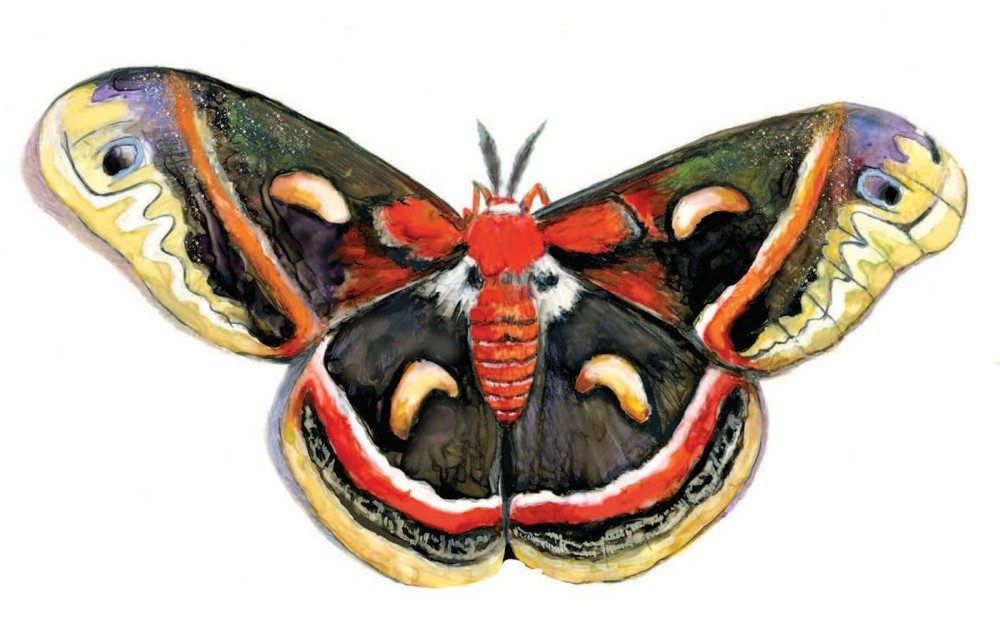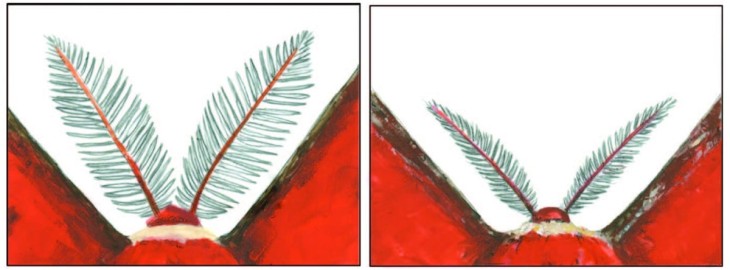
Twenty-five years ago, a student brought me a dead, tattered specimen of a moth. Its prodigious wingspan, colorfully banded fuzzy body, and spectacular wings were unmistakable: cecropia moths stand out from the crowd. With 5- to 7-inch wingspans, cecropias (Hyalophora cecropia) are North America’s largest moth, and they also outsize all our butterflies. Although this species is reasonably common, few of us get to see one. These giant silk moths (family: Saturniidae) are nocturnal, and hide in shaded vegetation during daylight hours.
Cecropia moths emerge from their cocoons in late spring and early summer, often in two pulses. In the Northeast, their flight season extends between May and early July. The adult moths live for about two weeks. They lack mouthparts and subsist on caloric reserves that they built up as caterpillars during the previous summer.
Adult cecropias have a singular mission – reproduction – and males may fly long distances to mate. The males’ large, featherlike antennae, distinguishable from the slenderer antennae of females, are studded with olfactory openings called olfactory sensilla (singular: sensillum) that detect female pheromones on the wind from miles away. Insects use their paired antennae to determine the direction odors come from and follow pheromone trails upwind.
How far will male cecropias fly, lured by scent? A sit-down interview with an exhausted moth will not yield answers, and I’m unaware of any conclusive studies. However, a 1970s study of male Polyphemus moths (a somewhat smaller member of the Saturniidae family) tracked distances of individual flights using fluorescent powders and minute wing tags. Researchers recorded Polyphemus moths covering an impressive 4½-mile distance within 24 hours, and it’s likely that cecropias can manage comparable distances.
Not all male moths are successful in their reproductive quests however. Female bolas spiders release a chemical that mimics the cecropia moth pheromone. When a lovelorn male gets too close, the spider flings a sticky ball of silk at the moth and reels him in for supper.
When mating is successful, the female lays mottled white-and-reddish-brown eggs on plants suitable for her offspring. Unlike many insects, cecropia moths are not especially picky eaters. The range of host plants is broad and includes most maples, birches, willows, ashes, and even spruces. Rose and several other shrubby species round out the menu.
The best time to look for cecropia caterpillars is in August and early September. During later instars – or stages of development – the caterpillars are almost as spectacular looking as their adult forms. In their first instar, they are small, black, and hairy. After eating their fill, fattening up, and molting for the first time, the caterpillars are yellow and brighten as their skin stretches, inflates, and spaces out the tufts of black hairs.
Third, fourth, and fifth instar caterpillars are shockingly bright green, with hair-topped protuberances, organized in rows that have different colors depending on where they’re located on the caterpillar’s body. Those on top of the thorax are red, those on the abdomen are yellow, and the ones sticking out sideways from all body segments are blue. In their fifth instar, the caterpillars may grow to lengths of up to 4½ inches long, and they begin to turn blue as they approach pupation.
All this growing and feeding occurs over the course of about five weeks. Once fed to satiation, caterpillars set to work preparing for the longest part of the life cycle: pupation. Before they extrude the first strand of silk, the caterpillars spend up to a full hour defecating, shedding a third of their body weight in the process. It sounds extreme, but it makes for a tidy puparium.
Caterpillars construct their winter-worthy silken homes in two layers. They start by spinning the outer layer, a process that takes about a day and a half. Recent research demonstrated that cecropia caterpillars have an internal odometer that measures the total length of silk produced. Once the appropriate length is incorporated into the outer shell, the caterpillar “paints” this layer with a hardening liquid secreted from a gland near its rear end. As this liquid dries, it gives the cocoon a brown to tan color.
After painting, the larva spins the inner layer that is separated from the outer layer by loosely packed silk. Although the cocoon must be durable, it can’t be sealed so tight that it becomes a death trap for the adult moth. And so the larva builds “escape valves” – or weak spots – into both the inner and the outer silk layers. The emerging moth’s head will push through both of these exit points as it emerges.
This summer you may find the former home of a cecropia moth, safely ensconced along the length of a twig in the woods. Look for tan to brown baglike structures measuring in at 4 or 5 inches in length. The cocoon may appear as a tightly wrapped structure roughly an inch wide, or a baggier morph about 2 inches wide. If you find one still intact, for example, on a pruned branch from a yard tree, consider sticking it back where it came from. Whatever minimal leaf damage that a solitary cecropia caterpillar may cause will be well compensated by the chance to observe its spectacular development.



Discussion *